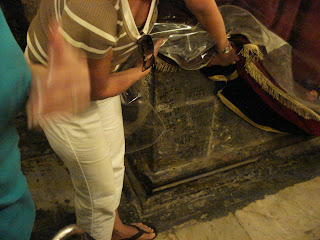We proceeded down the Mount of Olives to the Church of the Agony and the Garden of Gethsemane. In Christian tradition, Jesus and his Disciples would visit the Gethsemane each evening to pray. According to the Gospel of Luke, the anguish Jesus felt in the garden about what he was supposed to do was so great that he perspired blood. The Greek Orthodox also believe that Gethsemane was the site where the Virgin Mary was buried and assumed to Heaven (Catholics believe the event took place in Ephesus in Turkey).
The Church of the Agony rests on the site of two previous churches. The inside of the church houses the bedrock that Jesus prayed against waiting for the Romans to come and arrest him. The present church was built in 1919 to 1926 and was funded by several different countries (hence the alternate title of The Church of All Nations). The church uses dark colors inside to mirror the gloom of Jesus' situation. Even the ceiling is painted dark blue to simulate the night sky.
After leaving the Garden, we made our way into the city gates of Jerusalem. The present city is quite smaller than how the city would have appeared in the time of Jesus. Our first stop was the Upper Room and David's Tomb. Tradition holds that the Disciples and Jesus celebrated the Last Supper (Maundy Thursday) above the site where King David is buried. The Lower Room where David is buried is divided into two sections, one for women and one for men. The site of the Last Supper is situated upstairs above the tomb. The building was constructed by soldiers during the Crusades.
Jerusalem is divided into four quarters: The Jewish Quarter, The Christian Quarter, the Armenian Quarter, and the Arab Quarter. The Jewish Quarter also displays the large menorah that is being built in preparation for the Third Temple.
We made our way thru the Armenian quarter into the Jewish Quarter and the Western Wall. An important religious site for Jews, some portions of the wall date back to 19BC, during the Second Temple period of Jerusalem, although later layers were added starting in the 7th century. Of course the Wall is divided into two sections, one for men and one for women.
The common practice at the wall is the meditate or pray. I, along with most other visitors, placed written notes in the crevices in the wall. Twice a year, the notes are collected and buried at the Mount of Olives.
The Church of the Agony rests on the site of two previous churches. The inside of the church houses the bedrock that Jesus prayed against waiting for the Romans to come and arrest him. The present church was built in 1919 to 1926 and was funded by several different countries (hence the alternate title of The Church of All Nations). The church uses dark colors inside to mirror the gloom of Jesus' situation. Even the ceiling is painted dark blue to simulate the night sky.
After leaving the Garden, we made our way into the city gates of Jerusalem. The present city is quite smaller than how the city would have appeared in the time of Jesus. Our first stop was the Upper Room and David's Tomb. Tradition holds that the Disciples and Jesus celebrated the Last Supper (Maundy Thursday) above the site where King David is buried. The Lower Room where David is buried is divided into two sections, one for women and one for men. The site of the Last Supper is situated upstairs above the tomb. The building was constructed by soldiers during the Crusades.
Jerusalem is divided into four quarters: The Jewish Quarter, The Christian Quarter, the Armenian Quarter, and the Arab Quarter. The Jewish Quarter also displays the large menorah that is being built in preparation for the Third Temple.
We made our way thru the Armenian quarter into the Jewish Quarter and the Western Wall. An important religious site for Jews, some portions of the wall date back to 19BC, during the Second Temple period of Jerusalem, although later layers were added starting in the 7th century. Of course the Wall is divided into two sections, one for men and one for women.

















1 comment:
awsome pictures and commentary on your middle east travels Ron.
Post a Comment